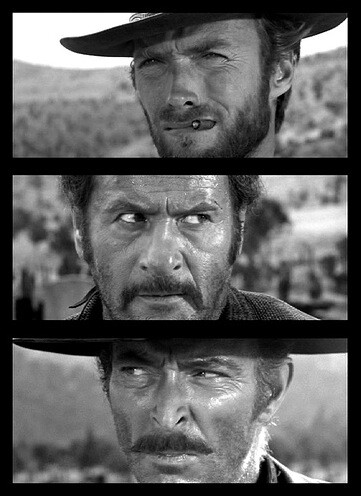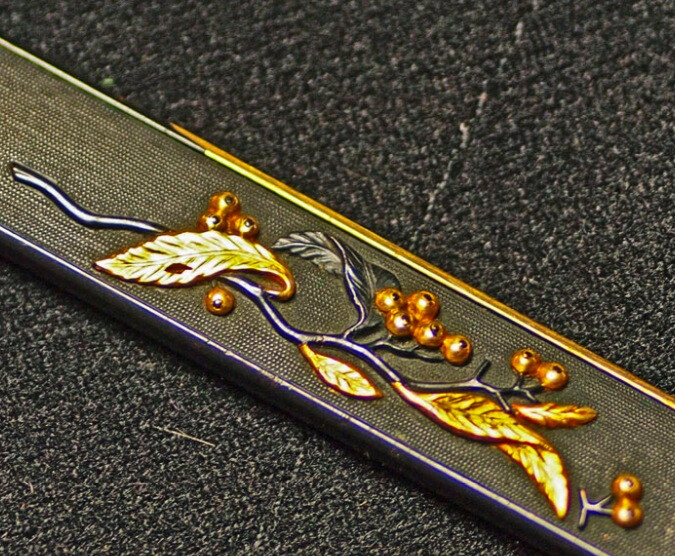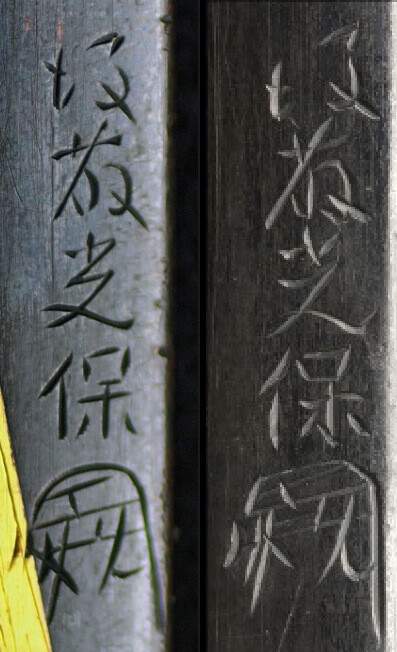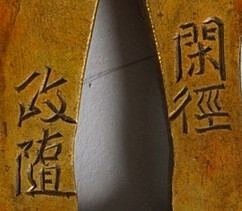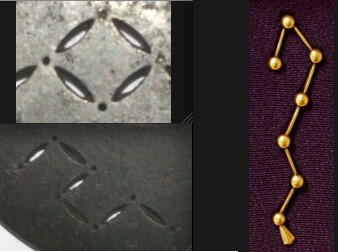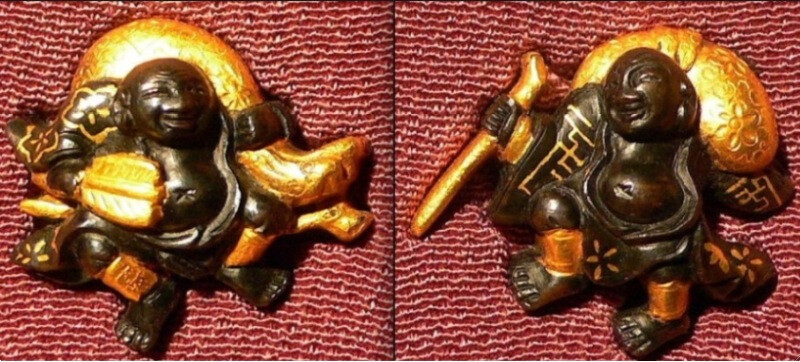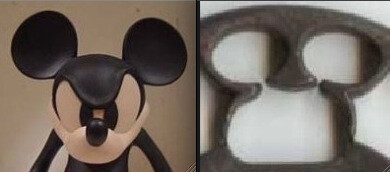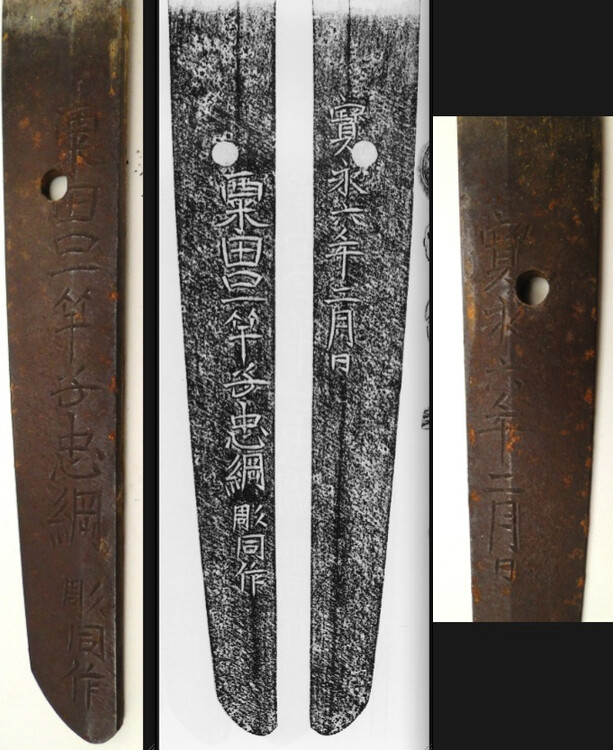-
Posts
779 -
Joined
-
Days Won
1
Content Type
Profiles
Forums
Events
Store
Downloads
Gallery
Everything posted by reinhard
-
-
"I treat every customer like family." I wonder what his family looks like. reinhard
-

Mei translation into English needed for Kozuka blade&handle
reinhard replied to bomulder's topic in Translation Assistance
This looks like a nice and quite typical Waki Goto-style kozuka in pretty good condition. (BTW Christies offered many kodogu of much lesser quality in the past, Brian). Like Franco said: Safe attribution to KAKUJO cannot be done by consulting a reference book or two. Workmanship is as important as the mei. Therefore the kozuka should be shown to someone familiar with the work of KAKUJO. - Take your time. Your precious looks worthwhile. However I do share some doubts with Curran as far as the mei is concerned. reinhard -
I can't follow your logic. You are considering this book (which is worth every cent BTW) too expensive to be shipped and on the other hand you are intending to buy doubious swords you have never seen nor know much about? - Well, you can't start collecting or doing sword-business by just going online. It takes much more than that. Anyway, I strongly recommend this book to everybody. It is representing in a fabulous way the quintessence of a man whose connoisseurship is undisputed even by his critics. reinhard
-
Do your homework, Martin, then come back. reinhard
-

YASUMITSU FIRST GENERATION BIZEN - IDENTIFICATION HELP
reinhard replied to NihontoEurope's topic in Nihonto
What you need to know about O-SA for starters: "During the early times of his career, he followed the the classical tradition which had been inherited in the RYOSAI, SAIREN and JITSUA line largely out of their originally Yamato-den background. However SA began to introduce the Soshu style, which resulted in a highly more clear and refined ji-ha workmanship.... Inclusion of SA among the "ten disciples of MASAMUNE" is based on SA's innovation in bringing in totally new elements to his own old heritage. However, taking into consideration of the confused historical condition at that time, we cannot help remaining sceptical about the barest possibility of SA having really come to Kamakura to train directly under MASAMUNE. It is much more reasonable to assume that the Soshu-den, which was giving a great impact in the then sword world because of its novelty, was reaching far enough to influence the sword world even in Kyushu. It seems most timely that military powers from the Kanto region, where Kamakura was centrally located, were sending their forces to northern Kyushu. In Kemmu 3rd year (1336) Ashikaga Takauji's forces landed on a seashore called Ashiyatsu in Chikuzen after they were defeated by the Shogunate's forces led by Kitabatake Akiiye. Ashikaga's troops stationed there for some two month until they reinforced their military forces. Also, another Ashikaga troop remained in Kyushu for a few years around Teiwa (1345-50) and Bunna (1352-56) times to enjoy a temporary power locally. Those Kanto warriors came with works of top ranking Soshu sword-makers and thus very likely gave Samonji opportunities to come across masterful Soshu swords. It should be noted that there are SA's (scarcely) dated works representing Kemmu 5 (1338, now retempered), Ryakuo 2 (1339, 2 specimen) and Ryakuo 3 (1340). There is also a Kano 1st year (1350) date given in a work of YUKIHIRO, who followed O-SA'S workmanship most faithfully. Thus it can be conjctured that changes in O-SA's style took place after Ryakuo (1338-42) and before Kano (1350-52), i.e. around Koei (1342-45) and Teiwa (1345-50) times." About the famous "Kosetsu" tachi: "This wide tachi in the most sturdy blade structure, however, has a kissaki yet to be fully extended and a kasane not so thin yet, which indicates it has a blade structure characteristic of the Nanbokucho times shortly before the change into the Enbun-Joji style (1356-68) took place." (BTW: Shohei era lasted from 1346 to 1370). These are excerpts from a comment on Kosetsu Samonji by Tanobe-Sensei. I added some numbers in brackets. reinhard -

YASUMITSU FIRST GENERATION BIZEN - IDENTIFICATION HELP
reinhard replied to NihontoEurope's topic in Nihonto
No, you don't. Read carefully. Instead of considering yourself on eye-level with one of Japan's undisputed authorities, you better start reading fundamentals again. reinhard -
"I will now give you a lecture on naginata blades. As is clear in the original word "nagi-gatana" once used to call what is now named naginata, which is a corrupted as well as abbreviated way of pronouncing nagi-gatana, the primary use of the type of blades presently called naginata was to "mow-down" the enemy. Stories and drawings depicting naginata in actual use began to appear in literature written around the time of two successive battles between the Genji and the Heike starting 1056. More tales involving war heros' distinguished military services accomplished by use of naginata followed in war stories such as "Hogen and Heiji no Ran Monogatari" and "Genpei no Seisuiki". However, it now seems more appropriate to consider that naginata examples extant to date are all works from the mid Kamakura onward. To mention very old examples that I have come across, there are works of Ichimonji KORESUKE, Osafune NAGAMITSU, KAGEMITSU, Yoshioka Ichimonji SUKEMITSU, Fukuoka ICHIMONJI, Rai KUNITOSHI, Taema in Yamato, NORISHIGE in Etchu, Miike in Chikugo, and so on. The common characteristics of these naginata works lie in their sizes measuring around 51.5cm - 54.5cm in blade length and the overall modest widths, as well as the shape consisting of fairly uniform widths maintained toward the tip and the modest sori. With the turn of the Nanbokucho period, however, enormously long o-naginata, just like the o-dachi of the same period, came into being. Their lengths measured as long as 75.75cm - 78.8cm. The shape consisted of wide mihaba, exaggerated width in the upper portion, and fairly marked sori; but they were made very thin in kasane, as in the case of the contemporary o-dachi works, therefore keeping a good balance on the whole. The most important thing to be noted here, however, is the edge curve of the point which is rather straight (fukura kareru). This has an effect in making the blade look very sharp, but a more important purpose of taking such a shape in terms of practical merits must have been the greatest possible cutdown in weights. It is also true and another important point to be noted of the naginata of Nanbokucho days that some of them were considerably smaller in overall sizes but their shapes and styles as a whole were perfectly homologous to those of o-naginata. It should be mentioned in this connection that the naginata in Muromachi days was made to have a size approximately inbetween the Kamakura and the Nanbokucho works. In terms of saki-haba and sakisori, however, the Muromachi work was made to have far more exaggerated characteristics than the work of previous periods and such an exaggerated shape is often described as having a point like a thrown-back head. I think it is a pretty good statement describing the appearence of sori in Muromachi blades. Further in the Muromachi period, naginata blades attained the all-time-high popularity and, therefore, more works remain to date from this period. On the other hand, it is also true that naginata were obviously considered minor, informal weapons to be used in battlefields, therefore, disposables when compared with tachi and other forms of blades. This is probably why there are no very old naginata examples extant from Heian and early Kamakura days. It was probably in the mid Kamakura period that naginata of better quality began to be produced, and especially in the Nanbokucho period that outstanding naginata were produced in large numbers. Nevertheless the number of extant works is very small. This is because a great many of them have been largely shortened in later days and further re-formed into uchigatana or wakizashi styles which were attainable by cutting off the back of the point. These re-formed blades have been called either nagamaki-naoshi or naginata-naoshi.I should think it is more appropriate to call them naginata-naoshi. Now, on the relationship between nagamaki and naginata. It is likely the similarity existing between aikuchi and tanto: the term nagamaki derived from a certain style of koshirae to fit in naginata blades, and referred to the long (nagai) hilt finished in hirumaki style (narrowly spaced notches). A reference to the "naginata in nagamaki style" can be found in war tales such as "Heike Monogatari" and gives evidence to the validity of the above theory. Therefore nagamaki should properly be called naginata. Further there has long been an understanding that naginata refers only to those blades without yokote and that those formed with the yokote should be classified as nagamaki. This also is quite erroneous. It should be added that a considerable number of naginata were made in early parts of the Shinto period. They took a form most closely resembling the style of Nanbokucho naginata. Hardly any truly excellent naginata were made in mid Edo days, but there were some made almost solely for decorative purpose. With the turn of the Shin-shinto period, the form of the naginata began taking large sizes." Sato KANZAN (in English Token Bijutsu no.10) Let's leave it at that. Nobody here is qualified to question KANZAN's authority unless he's determined to make a fool out of himself. reinhard
-
Checked the mei and it looks pretty good. Workmanship is also promising from a distance. Please handle this tsuba with care. regards reinhard
-
Janusz, the name on the left side is: SHOZUI. This is a very big name usually associated with the founder of the Hamano-school. reinhard
-
John is correct although he picked the wrong kanji for illustration. There is a horizontal line which is difficult to see. Compare Nelson no.32 for "2" and no.1555 for "3". Then have a close look at the pic again. You will see a faint line making the kanji read "3". reinhard
-
Thank you for the link and info, Ford. I didn't know that. Now that we can see the entire koshirae, do you agree with me that this koshirae matches most, if not all criteria?. It was hand made in a simple way. No precious materials nor outstanding skills were involved. It was not to be worn by a samurai. Wether it was functional in daily life or what region it was made in I cannot tell though. Remains the question what the mei means here. Can it be attributed to an individual artist or is it just a kind of trademark? I haven't found out yet. I was bringing up the term "mingei" in a more casual and unreflected way to consider the differences between sophistication associated with educated samurai, eventually including star-constellations, and pure, ornamental design with a resemblance to the afore-mentioned. reinhard
-
Just telling from overall style and craftsmanship. - BTW Who was Yanagi? reinhard
-
This koshirae is mingei. You are aware of this, aren't you? BTW The proximity to shippo (-design) in all of the afore-mentioned examples was intentional. reinhard
-
I agree with Clive here. There is one spot in the upper area having a resemblance to shippo, but most of the design has not. Sukashi is probably depicting a particular star constellation. For comparison see the menuki in the attachment (celestial dragon represented by seven stars). reinhard
-
Just for completion: There is a kanji "machi" between "izumi" and "dori", meaning "town, street, quarters". reinhard
-
My guess would be: Hoshu Mie (no) ju Kai hon Fujiwara YUKINAGA Keicho roku nen ...gatsu hi YUKIHISA...saku meaning: Fujiwara YUKINAGA, resident of Mie in Bungo province, originally from Kai province (this is probably the YUK 351 (first generation) in Hawley's compilation) Sixth year of Keicho era (1601)....month, day, YUKIHISA....made this Eventually a joint work (gassaku). reinhard
-
The "winner" of this auction will have to face an ugly truth like so many. reinhard
-
A pair of tiny menuki depicting Hotei. They were made for tanto by Yamasaki ICHIGA. Don't strive for more than you can carry on your back. reinhard
-
You've missed the point one more time. This was never about finding quotes confirming your particular theory. Neither Wakayama nor Haynes are capable of attributing later TOU mei to an individual, identifiable artist. They are just confirming the MEI appeared again later. When I said: "Prove me wrong" I wasn't asking for quotes from books (I can read them myself) but for presenting us with example(s) of tosogu with later TOU-mei that can be SAFELY attributed to an individual. You've failed to do so far. reinhard
-
Francois, as far as this particular tsuba is concerned, you won't need books of reference about names and signatures in the first place. The name TOU on the pile is more likely to be part of the design than some artist's signature. Real mei on kozuka are usually found on the backside and are not part of the design. You better focus on style and workmanship here. reinhard
-
The nengo is Hoei (not Horeki) roku nen... The waterfall-ascending carp theme is one of Ikkanshi TADATSUNA's original designs for horimono. It is quite rare though. Design and execution of the horimono of the blade in question are not very good. Taking into consideration the mei saying: "hori dosaku", i.e. "the maker of the blade also engraved the horimono" should rise a red flag. The mei is quite close to the original, but it is in all probability gimei. Check Ikkanshi's signatures with a Hoei nengo and look at the kanji for "ei" in "Hoei" (see attachment for comparison). This is not supposed to be the substitute for a real expertise with the blade in hand. All I'm saying is: Be careful with objects like these. BTW, the koshirae is a textbook example of a koshirae made for export. reinhard
-
This would be an interesting new topic which is overdue. It should not be "either...or"-polemics though, but more of a differentiated analysis. All of them, if you know HOW to use them. reinhard


